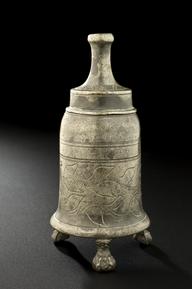





Circular brass fumigator, perforated, with stemmed base and scroll handle, lid hinged, Spanish, probably 19th century
Sweet smelling herbs and plants were set alight inside this brass fumigator and the smoke given off was used to purify and disinfect the air around the person carrying the torch. It is based on the miasma theory, the idea that disease was caused by bad smells in the air from rotting animal matter, human waste and stagnant water. This theory of disease also appeared to give an explanation for why rubbish strewn poor areas with bad sanitation were more at risk from disease. This fumigator was probably made in Spain.
Details
- Category:
- Nursing & Hospital Furnishings
- Collection:
- Sir Henry Wellcome's Museum Collection
- Object Number:
- A118588
- Materials:
- brass
- Measurements:
-
overall: 187 mm x 204 mm 118 mm, .6kg
- type:
- fumigator
- credit:
- Gonzales & Barran & Vindel, P. & Maroto, L




